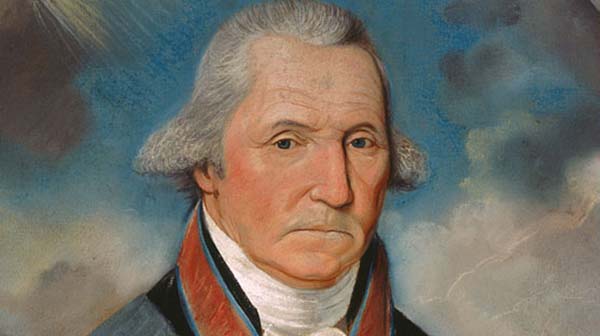George Washington sometimes wore a gold and silver bald eagle badge that contained about 160 diamonds of various sizes and cuts, 28 marquis-shaped emeralds and 10 rubies.
Washington’s gold and silver bald eagle badge was a gift from the French branch of the Society of the Cincinnati, a fraternal organization formed by the commissioned officers of the Continental Army. He wore the badge only at Society meetings and for his annual birthday ball.
But for more than 200 years, the badge has been surrounded by mystery. Information was scarce about who commissioned it, who paid for it and who had it.
Bald Eagle Insignia
The suggestion of the bald eagle as the Society’s insignia was made by Major Pierre L’Enfant, a French artist and officer (Corps of Engineers) who joined the American Army during 1777. In designing the insignia with an eagle of fierce appearance and outspread wings, he said that “the Bald Eagle, which is peculiar to this continent, and is distinguished from those of other climates by its white head and tail, appears to me to deserve attention.”
During 1783, L’Enfant, who later became a member of the Society and helped plan the Federal City (renamed Washington, D.C.), was commissioned by Washington to travel to France to oversee the production of the first eight gold eagle badges that were based on the insignia. Washington planned to distribute these badges to ranking members of the Cincinnati. Other members of the group also provided L’Enfant with commissions for additional badges.
In addition to the eagle, the insignia contains an image of Lucius Quinctius Cincinnatus, a farmer who left his land to accept a term as consul over Rome during a war emergency. After the battle, and similar to the actions taken by American officers after the Revolutionary War, he returned his power to the Roman senate and went home.
The Diamond Eagle
L’Enfant’s commissions, however, did not mention a diamond eagle. This version of the insignia was mentioned in a letter written by Charles Hector, Comte D’Estaing, the elected president of the French branch of the Society. As an admiral of a French fleet, D’Estaing supported the American cause in Newport, New York and Savannah, but he did not have much success.
Reportedly uncomfortable with his performance in America, D’Estaing dedicated his efforts to have naval officers who participated in the war accepted into the Society. In the letter to former French ambassador Ann Cesar, the Chevalier de la Luzerne, he stated that he had heard about a diamond eagle to be created for Washington.
D’Estaing persuaded the jeweler to allow him to purchase it as a personal gift for the general. He said that it was to be presented “by French sailors,” calling it “a little token” that would gain value when it was “placed in the buttonhole of General Washington.”
The Marquis de Lafayette, who fought under Washington and admired him as a father, championed d’Estaing’s call to include naval officers in the Society. He encouraged everyone to support the admiral’s mission and to allow naval officers in the Society to have eagle badges.
Lafayette was one of the wealthiest men in France. When he heard about the diamond eagle for Washington, he would not have thought twice about its cost and its presentation. While no records exist, it is not unlikely, based on his strong feelings toward Washington, that he could have contributed to the purchase of the diamond eagle.
L’Enfant brought the one diamond eagle and the other gold eagles to American during 1784. On May 15, Washington thanked d’Estaing for his “absolutely inestimable gift” and told him that all admirals and captains of the French navy, whose rank corresponded to army colonels, “who have cooperated with the armies of the United States” had a right to join the Society.
The Diamond Eagle Changes Hands
After Washington died in December 1799, Martha Washington gave the diamond eagle to Alexander Hamilton, who also served under the general during the war. The following year, Hamilton was elected as the Society’s second president.
When Hamilton died in 1804 shortly after he was shot during a duel with Aaron Burr, the eagle passed on to South Carolina’s Charles Cotesworth Pinckney, who became the third president of the Cincinnati during 1805. Pinckney donated the eagle to the Society during 1811.
Since then, each new president of the Society has had the privilege to wear the diamond eagle as a treasured symbol of the bonds between Revolutionary War soldiers and sailors. However, it rarely has been seen by the American public.
Eagles on Display
For a short time, until January 2010, the Washington diamond eagle will be exhibited at Mount Vernon as part of the “George Washington & His Generals” celebration. Displayed for the public on only three previous occasions, the diamond eagle has returned to Mount Vernon for the first time since Washington’s death.
Another rare Society eagle pin is on display with the diamond eagle. The Washington-Lafayette eagle pin is on loan to Mount Vernon by La Grange, Lafayette’s estate near Paris. It has returned to Washington’s home for the first time since 1802.
This pin was presented to Lafayette by Washington’s adopted granddaughter, who inherited it from Martha Washington, during Lafayette’s triumphant 1824-25 tour of the U.S. It is known to have been exhibited publicly only four times in its 225-year history. The last time U.S. audiences saw this pin was at the Columbian Exposition in Chicago (1892-1893).








